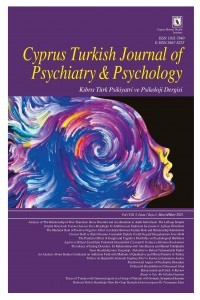The Relationship Between Traumatic Stress Symptoms and Basic Psychological Needs, Irrational Beliefs, and Mood in a Non-Clinical Population
The Relationship Between Traumatic Stress Symptoms and Basic Psychological Needs, Irrational Beliefs, and Mood in a Non-Clinical Population
___
- Aldao, A., Hoeksama, S. & Schweizer, S. (2010). Emotion-regulation strategies across psychopathology: A meta-analytic review. Clinical Psychology Review: 30(2), 217-237.
- Artıran, M. (2019). Ergenlerde olumlu ve olumsuz duygulanımın yordanmasında temel psikolojik ihtiyaçlar irrasyonel inanışlarının rolü. Anemon Muş Alparslan Üniversitesi Sosyal Bilimler Dergisi, 7, 79-85.
- Boduszek, D., Shevlin, M., Adamson, G & Hyland P. (2013). Eysenck's personality model and criminal thinking style within a violent and nonviolent offender sample: Application of propensity score analysis. Deviant Behavior: 34(6), 483-493.
- Botcharova, O. (2001). Implementation of track two diplomacy: Developing a model of forgiveness. In: R. Helmick & R. Peterson (Edt.), Forgiveness and reconciliation: Religion, public policy and conflict transformation (p. 291). Templeton Foundation Press.
- Corey, G. (2015). Psikolojik danışma, psikoterapi kuram ve uygulamaları. (Çev: T. Ergene), Mentis Yayıncılık.
- Çorapçıoğlu, A., Yargıç, İ., Geyran, P. & Kocabaşoğlu, N. (2006). Olayların Etkisi Ölçeği (IES-R) Türkçe versiyonunun geçerlilik ve güvenilirliği. Psikiyatri, Nöroloji ve Davranış Bilimleri Dergisi, 44(1), 14-22.
- Deci, Edward L., Ryan, R. M. (2000). The "What" and "Why" of Goal Pursuits: Human Needs and the Self-Determination of Behavior. Psychological Inquiry: An International Journal for the Advancement of Psychological Theory, 11(4), 227-268.
- Ehring T, Quack D. (2012). Emotion regulation difficulties in trauma survivors: The role of trauma type and PTSD symptom severity. Behavior Therapy: 41(4), 587-598.
- Ellis A. (1995). Rational emotive behavior therapy. Current psychotherapies, 5, 162-196.
- Feder, A., Ahmad, S., Lee, E., Morgan, J., Singh, R., Smith, B., Soutwhick, S. & Charney, D. (2013). Coping and PTSD symptoms in Pakistani earthquake survivors: purpose in life, religious coping and social support. Journal of Affective Disorder,147(1-3), 156-63.
- Fraenkel, J. R., Wallen, N. E. & Hyun, H. H. (2012). How to design and evaluate research in education. Von Hoffman Press.
- Gençöz, T. (2000). Positive and Negative Affect Schedule: A study of validity and reliability. Türk Psikoloji Dergisi, 15(46), 19–28.
- Hyland, P., Shevlin, M., Adamson, G. & Boduszek, D. (2014). The organization of irrational beliefs in posttraumatic stress symptomology: Testing the predictions of REBT theory using structural equation modelling. Journal of Clinical Psychology, 70(1), 48-59.
- Jabson, L., O’Kearney, R. (2009). Impact of cultural differences in self on cognitive appraisals in posttraumatic stress disorder. Behavioural Cognitive Psychotherapy, 37(3), 249-66.
- Jobson L, O'Kearney R. (2008). Cultural differences in personal identity in post-traumatic stress disorder. British Journal of Clinical Psychology, 47(1), 95–109.
- Karataş Z., Yavuzer Y. (2018). Psikolojik danışma ve psikoterapi kuramları. Pegem Akademi.
- Karasar, N. (2011). Bilimsel araştırma yöntemi. Nobel Akademik Yayıncılık. Kesici, Ş., Üre, Ö., Bozgeyikli, H., Sünbül, A. (2003). Temel psikolojik ihtyaçlar ölçeğinin geçerlik ve güvenirliği, VII. Ulusal PDR Kongresinde Sunulan Bildiri. Malatya: 2003.
- Kleim, B., Gonzalo, D. & Ehlers, A. (2011). The depressive attributions questionnaire (DAQ): Development of a short self-report measure of depressogenic attributions. Journal of Psychopathology and Behavioral Assesment, 33, 375.
- Kolts, R., Robinson, A. & Tracy, J. (2004). The relationship of sociotropy and autonomy to posttraumatic cognitions and PTSD symptomatology in trauma survivors. Journal of Clinical Psychology, 60(1), 53-63.
- Miron, L., Seligowski, A., Boykin, D., Orcutt, H. (2016). The potential indirect effect of childhood abuse on posttrauma pathology through self-compassion and fear of self compassion. Mindfulness, 7(3), 596-605. doi:10.1007/s12671-016-0493-0, H. (2016).
- Monson, C. M., Price, J. L., Rodriguez, B. F., Ripley, M. P. & Warner, R. A. (2004). Emotional deficits in military-related PTSD: An investigation of content and process disturbances. Journal of Traumatic Stress, 17(3), 275–279.
- Nietlisbach, G. ve Maercker, A. (2009). Effects of social exclusion in trauma survivors with posttraumatic stress disorder. Psychological Trauma: Theory, Research, Practice, and Policy, 1(4), 323–331.
- Ryan, R. M. ve Deci, E. L. (2000). The darker and brighter sides of human existence: Basic psychological needs as a unifying concept. Psychological Inquiry, 11(4), 319-338.
- Ryan, R. M. ve Deci, E. L. (2008). Self-determination theory and the role of basic psychological needs in personality and the organization of behavior. İçinde: O. P. John, R. W. Robins, & L. A. Pervin (Edt.), Handbook of personality: Theory and research (s. 654–678). The Guilford Press.
- Seligowski, A. V., Rogers, A. P. & Orcutt, H. K. (2016). Relations among emotion regulation and DSM-5 symptom clusters of PTSD. Personality and Individual Differences, 92, 104–108.
- Shapinsky, A. C., Rapport, L. J., Henderson, M. J. & Axelrod, B. N. (2005). Civilian PTSD scales: Relationships with trait characteristics and everyday distress. Assessment, 12(2), 220-230.
- Shepherd, L., Wild, J. (2014). Emotion regulation, physiological arousal and PTSD symptoms in trauma-exposed individuals. Journal of Behavior Therapy and Experimental Psychiatry, 45(3), 360-7.
- Watson, D., Clark, L. A. (1984). Negative affectivity: The disposition to experience aversive emotional states. Psychological Bulletin, 96(3), 465–490.
- Zakiei, A., Karami, J., Alikhani, M., Ghasemi, S. R. & Rajabi-Gilan, N. (2014). The relationship between alexithymia, irrational beliefs, positive and negative emotions with mental disorders. Hormozgan Medical Journal, 18(5), 392-402.
- ISSN: 1302-7840
- Yayın Aralığı: Yılda 4 Sayı
- Başlangıç: 2000
- Yayıncı: Kıbrıs Ruh Sağlığı Enstitüsü
Beyaz Şeytan Filminin Bilişsel Davranışçı Psikoterapi Perspektifinden Değerlendirilmesi
Melek ÖZTÜRKLER, Meryem KARAAZİZ
Nihal MAMATOĞLU, Şeyhmus AKSOY
Covid-19 Pandemisi Sırasında Eş Şiddeti: Alanyazın Çalışması
Zihniye OKRAY, Cemaliye DİREKTÖR, Güley Bilgi ABATAY
Mehmet Cüneyt BİRKÖK, Cihat ALBAYRAK
Burcu TÜRK, Aslı YAYAK, Nurcan HAMZAOĞLU
Covid-19 Stresi Altındaki Annelerde Maternal Bağlanma ve Önleyici Müdahale Yöntemleri
